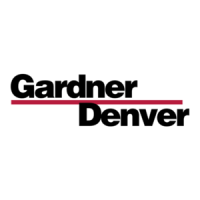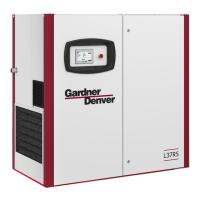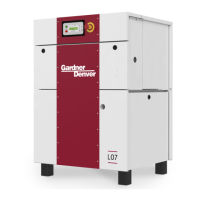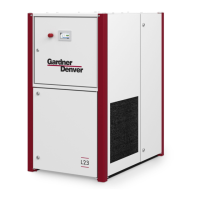Do you have a question about the Gardner Denver L30RS and is the answer not in the manual?
Ensures trouble-free operation through periodic maintenance and servicing as per manual guidelines.
Conditions for warranty claims, emphasizing use of genuine parts for servicing to avoid invalidation.
Indicates a hazard with a high level of risk, potentially resulting in death or serious injury if not avoided.
Details warnings for electric shock from condensers, burn hazards, and general cautionary notes.
Covers safety prohibitions like asphyxiation and mandatory actions like reading manuals and proper handling.
Section for filling in distributor contact information for service and parts.
Details on the design and manufacturing of Gardner Denver screw compressors for long service life and reliability.
Specifies the machine's intended use for compressing atmospheric air and hazards if misused or operated improperly.
Emphasizes the importance of proper maintenance for ensuring compressor performance and longevity.
Provides general notes on operating the compressor safely, economically, and increasing its service life.
Guidance on contacting Gardner Denver for faults, spare parts, and repairs with genuine parts.
Instructions on providing specific unit information (model, serial number) for inquiries or parts orders.
Lists conditions under which warranty claims are void, such as user errors or unauthorized modifications.
Highlights the DANGER of not observing safety regulations and refers to Section 4.
Statement reserving the right to make technical changes without prior notice.
General safety rules for working with compressors, emphasizing manual adherence and trained personnel.
Details dangers of compressed air, including high speed, connections, hoses, and expansion, with safety measures.
Covers dangers like electric shock, power quality issues, unexpected remote startups, and noise.
Addresses dangers from bacteria (legionella) in cooling water and oil leakage into the cooling circuit.
Details dangers during lifting and moving, like falling parts and incorrect hoisting.
Covers general workplace safety, including adherence to regulations, fire safety, and handling chemical substances.
Highlights dangers from wear of safety components, line perishability, oil spurting, electric shock, and faulty sensors.
Covers dangers during maintenance, such as pressurized parts, incorrect spare parts, electric shock, and unexpected startups.
Explains dangers of unauthorized modifications, use of non-genuine parts, and operating with non-functioning protective equipment.
Illustrates and labels the main components of the screw compressor unit.
Presents a schematic diagram of the compressor's system with labeled components and functions.
Details the flow and operation of the oil circuit within the compressor, including temperature-dependent routing.
Explains the path of intake air through the compressor, its cooling, separation, and delivery to the network.
Describes the system control logic, including standstill conditions and starting procedures.
Provides steps for stopping the compressor system normally and its automatic shutdown sequence.
Explains the compressor's automatic operation cycle, including load, offload, and standby modes.
Details the operation of the suction regulator in both load running mode and idling mode with diagrams.
Provides safety instructions and guidelines for transporting the compressor unit, including lifting and securing.
Outlines installation requirements, including leveling, ventilation, safety notes, and placement considerations.
Specifies cooling air requirements and minimum duct cross-sections for optimal heat dissipation and performance.
Details the compressed-air connection procedure, safety warnings, and requirements for hoses and fittings.
Provides instructions and safety warnings for making the electrical connection for USA/CANADA versions.
Table listing recommended cable sizes and fuse ratings for various compressor types and supply voltages.
Instructions for checking and setting the fan motor protection switch for specific models.
Guidance on checking and setting the control-power transformer for proper system operation.
Detailed procedure for checking the oil level, including safety warnings and oil specifications.
Presents sound pressure level data for different compressor models according to ISO 2151.
Step-by-step guide for the initial commissioning of the screw compressor unit.
Procedure for recommissioning a compressor after it has been decommissioned or stored.
Explanation of the GD Pilot TS control display elements and indicators.
Steps for routine commissioning and startup procedures for the compressor unit.
Procedure for restarting the compressor after an automatic shutdown due to a malfunction.
Instructions for normally shutting down the compressor, emphasizing the use of the stop button.
Information on the function and usage of the emergency stop button.
Guidelines for performing maintenance work at specified intervals for optimal compressor satisfaction.
Details on the maintenance of the electric motor, noting it is permanently lubricated.
Overview of the maintenance and inspection schedule, with safety warnings for electrical work.
A detailed checklist for service and maintenance tasks categorized by operating hours.
Detailed procedure and safety precautions for changing the compressor oil.
A comprehensive maintenance schedule table for the L Series compressors, indicating intervals for various tasks.
Step-by-step guide on how to change the oil filter cartridge, including safety warnings.
Instructions for replacing the fine oil separator, with safety warnings and disposal information.
Procedure for changing the air intake filter, including safety warnings and filter replacement steps.
Information on checking and testing the pressure relief valve, with critical safety warnings.
Guidance on checking and setting connecting terminals and the control transformer, with high voltage warnings.
Instructions for checking and re-tightening screw connections in air, oil, and water circuits.
General advice on cleaning system parts with compressed air, emphasizing safety and avoiding oil residue.
Procedure for cleaning or changing filters for cool air intake and switch cabinet inlet.
Details inspection intervals for pressure reservoirs and electrical installations as per regulations.
Provides notes on lubrication for compressor lifespan and recommends specific oil types.
Specific instructions for changing the switch cabinet inlet filter, including filter pad replacement.
Troubleshooting steps for when the compressor unit fails to start, listing possible causes and remedies.
Diagnosing and resolving issues where the unit stops during the start-up phase.
Troubleshooting for the unit failing to reach the set mains pressure, covering sensor and regulator issues.
Addresses causes and solutions for the unit switching off unexpectedly, including temperature, motor, and sensor faults.
Troubleshooting steps for when idle pressure is too high, focusing on suction regulator and system discharge.
Diagnosing and rectifying causes of oil contamination in the compressed air.
Troubleshooting for oil found in the air filter, relating to suction regulator and separator issues.
Resolving issues where the pressure relief valve opens, often related to sensor faults or regulator problems.
Presents technical specifications for North America version L30-L37 compressors.
Technical specifications for the L30RS model in the North American market.
Technical specifications for the L37RS model in the North American market.
Technical specifications for L45 and L50 models in the North American market.
Technical specifications for the L45RS model in the North American market.
Provides layout plans and dimensional drawings for L30-L50 compressor models.
Layout plans and dimensional drawings specific to L30RS-L45RS compressor models.
Ensures trouble-free operation through periodic maintenance and servicing as per manual guidelines.
Conditions for warranty claims, emphasizing use of genuine parts for servicing to avoid invalidation.
Indicates a hazard with a high level of risk, potentially resulting in death or serious injury if not avoided.
Details warnings for electric shock from condensers, burn hazards, and general cautionary notes.
Covers safety prohibitions like asphyxiation and mandatory actions like reading manuals and proper handling.
Section for filling in distributor contact information for service and parts.
Details on the design and manufacturing of Gardner Denver screw compressors for long service life and reliability.
Specifies the machine's intended use for compressing atmospheric air and hazards if misused or operated improperly.
Emphasizes the importance of proper maintenance for ensuring compressor performance and longevity.
Provides general notes on operating the compressor safely, economically, and increasing its service life.
Guidance on contacting Gardner Denver for faults, spare parts, and repairs with genuine parts.
Instructions on providing specific unit information (model, serial number) for inquiries or parts orders.
Lists conditions under which warranty claims are void, such as user errors or unauthorized modifications.
Highlights the DANGER of not observing safety regulations and refers to Section 4.
Statement reserving the right to make technical changes without prior notice.
General safety rules for working with compressors, emphasizing manual adherence and trained personnel.
Details dangers of compressed air, including high speed, connections, hoses, and expansion, with safety measures.
Covers dangers like electric shock, power quality issues, unexpected remote startups, and noise.
Addresses dangers from bacteria (legionella) in cooling water and oil leakage into the cooling circuit.
Details dangers during lifting and moving, like falling parts and incorrect hoisting.
Covers general workplace safety, including adherence to regulations, fire safety, and handling chemical substances.
Highlights dangers from wear of safety components, line perishability, oil spurting, electric shock, and faulty sensors.
Covers dangers during maintenance, such as pressurized parts, incorrect spare parts, electric shock, and unexpected startups.
Explains dangers of unauthorized modifications, use of non-genuine parts, and operating with non-functioning protective equipment.
Illustrates and labels the main components of the screw compressor unit.
Presents a schematic diagram of the compressor's system with labeled components and functions.
Details the flow and operation of the oil circuit within the compressor, including temperature-dependent routing.
Explains the path of intake air through the compressor, its cooling, separation, and delivery to the network.
Describes the system control logic, including standstill conditions and starting procedures.
Provides steps for stopping the compressor system normally and its automatic shutdown sequence.
Explains the compressor's automatic operation cycle, including load, offload, and standby modes.
Details the operation of the suction regulator in both load running mode and idling mode with diagrams.
Provides safety instructions and guidelines for transporting the compressor unit, including lifting and securing.
Outlines installation requirements, including leveling, ventilation, safety notes, and placement considerations.
Specifies cooling air requirements and minimum duct cross-sections for optimal heat dissipation and performance.
Details the compressed-air connection procedure, safety warnings, and requirements for hoses and fittings.
Provides instructions and safety warnings for making the electrical connection for USA/CANADA versions.
Table listing recommended cable sizes and fuse ratings for various compressor types and supply voltages.
Instructions for checking and setting the fan motor protection switch for specific models.
Guidance on checking and setting the control-power transformer for proper system operation.
Detailed procedure for checking the oil level, including safety warnings and oil specifications.
Presents sound pressure level data for different compressor models according to ISO 2151.
Step-by-step guide for the initial commissioning of the screw compressor unit.
Procedure for recommissioning a compressor after it has been decommissioned or stored.
Explanation of the GD Pilot TS control display elements and indicators.
Steps for routine commissioning and startup procedures for the compressor unit.
Procedure for restarting the compressor after an automatic shutdown due to a malfunction.
Instructions for normally shutting down the compressor, emphasizing the use of the stop button.
Information on the function and usage of the emergency stop button.
Guidelines for performing maintenance work at specified intervals for optimal compressor satisfaction.
Details on the maintenance of the electric motor, noting it is permanently lubricated.
Overview of the maintenance and inspection schedule, with safety warnings for electrical work.
A detailed checklist for service and maintenance tasks categorized by operating hours.
Detailed procedure and safety precautions for changing the compressor oil.
A comprehensive maintenance schedule table for the L Series compressors, indicating intervals for various tasks.
Step-by-step guide on how to change the oil filter cartridge, including safety warnings.
Instructions for replacing the fine oil separator, with safety warnings and disposal information.
Procedure for changing the air intake filter, including safety warnings and filter replacement steps.
Information on checking and testing the pressure relief valve, with critical safety warnings.
Guidance on checking and setting connecting terminals and the control transformer, with high voltage warnings.
Instructions for checking and re-tightening screw connections in air, oil, and water circuits.
General advice on cleaning system parts with compressed air, emphasizing safety and avoiding oil residue.
Procedure for cleaning or changing filters for cool air intake and switch cabinet inlet.
Details inspection intervals for pressure reservoirs and electrical installations as per regulations.
Provides notes on lubrication for compressor lifespan and recommends specific oil types.
Specific instructions for changing the switch cabinet inlet filter, including filter pad replacement.
Troubleshooting steps for when the compressor unit fails to start, listing possible causes and remedies.
Diagnosing and resolving issues where the unit stops during the start-up phase.
Troubleshooting for the unit failing to reach the set mains pressure, covering sensor and regulator issues.
Addresses causes and solutions for the unit switching off unexpectedly, including temperature, motor, and sensor faults.
Troubleshooting steps for when idle pressure is too high, focusing on suction regulator and system discharge.
Diagnosing and rectifying causes of oil contamination in the compressed air.
Troubleshooting for oil found in the air filter, relating to suction regulator and separator issues.
Resolving issues where the pressure relief valve opens, often related to sensor faults or regulator problems.
Presents technical specifications for North America version L30-L37 compressors.
Technical specifications for the L30RS model in the North American market.
Technical specifications for the L37RS model in the North American market.
Technical specifications for L45 and L50 models in the North American market.
Technical specifications for the L45RS model in the North American market.
Provides layout plans and dimensional drawings for L30-L50 compressor models.
Layout plans and dimensional drawings specific to L30RS-L45RS compressor models.
| Model | L30RS |
|---|---|
| Type | Rotary Screw |
| Power | 30 hp |
| Flow Rate | 125 cfm |
| Max Pressure | 125 psig |
| Phase | 3 |
| Noise Level | 69 dB(A) |











